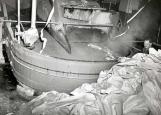49
They had automatic beaters on 7-8 and 5-6; they had a huge beater on 5-6. It was completely different. But 7-8 had their own beaters, and they had one operator later on and they had a walkway between the beaters so he could monitor both at the same time. Then they put lights on and horns when the machine broke, because they had a signal that they were breaking, and they had automatic showers that went on right away, so it was different, but they still had plug-ups.I remember working on 5-6 as a helper. That was during the war. That was a busy job - they were wide machines, and there was one person to each beater, one on 5, one on 6 - this was the original beaters. That was a tough job - when they broke you had to really hustle because a sheet was almost 1.5 times as wide as number 1,2,3,4, and they were going that much faster - they were doing about 1100 feet a minute, and I think number 1-2 were doing about 660 feet a minute, so there was a lot of paper coming down.
Taped interview
People of The White City
50
New Machine Room Broke BeaterCirca 1940
Powell River, British Columbia, Canada
 Credits:
Credits:P00608
Ted Cooper